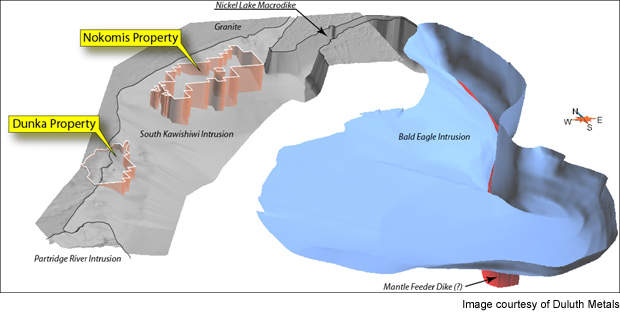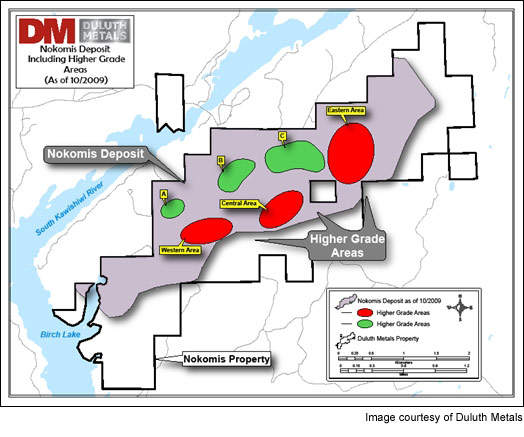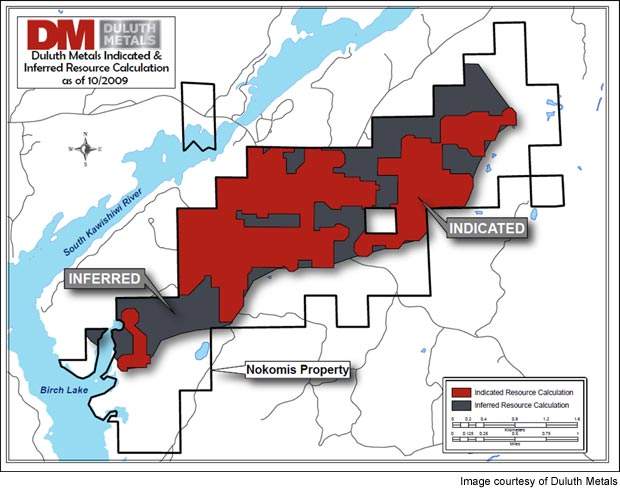The Nokomis deposit is located south east of the town Ely in Minnesota, USA, on the western section of the Nokomis property. Owned by Duluth Metals, the deposit is listed as one of the biggest combined base and precious metal resources to be developed in North America.
The preliminary assessment of the deposit was completed in January 2009. Following the establishment of the mine’s economics, a drilling programme was initiated in March 2010. The project will be developed by Duluth Metals and its joint venture partner Antofagasta.
Nokomis deposit reserves
The current resource estimate of the deposit includes 550 million tons of indicated resources graded at 0.639% copper, 0.2% nickel and 0.66g/t TPM (TPM = Pt + Pd + Au) for a copper equivalent (CuEq) grade of 1.51%. Inferred resources at the deposit total 274 million tons graded at 0.632% copper, 0.207% nickel and 0.685g/t TPM for a CuEq grade of 1.53%.
The deposit has more than the average grade of deposits hosted within the Duluth complex. Significantly higher-grade zones of copper, nickel, platinum, palladium, gold and silver are found in portions within the deposit.
Mine deposit geology
The deposit is hosted nearly 400m below the surface level within the Duluth complex. It extends to a depth of 1,200m and up to 3.5km along the known drilled off range.
Covering an area of 6,500 km2, the mine includes an Anorthosite series, a Troctolitic series and a distinct late-stage Felsic series complex. It comprises 12 mafic sub-intrusions that were placed into older rocks during a continental rift that took place over a period of ten to 12 millions years, approximately 1.1 billion years ago.
Sharp contacts with the footwall plunge south-east at -10° to -35°. Contacts to the hanging wall are gradational with the overlying basalts.
Nokomis deposit mineralisation
The deposit hosts a tabular zone of copper, nickel and platinum-group metals (PGM) mineralisation. Better-grade copper and nickel are typically concentrated within 30m of the main body near the top of the zone.
Minerals are hosted within troctolitic rocks found on the lower contact between the South Kawishiwi intrusion and the granitic rocks of the Giants Range Batholith.
The bottom zone of South Kawishiwi and the Partridge River intrusions contain significant resources of disseminated, lesser-grade copper and nickel sulphides that include anomalous platinum group elements (PGEs) locally.
At least nine deposits are outlined in the bottom 100m to 300m of the intrusions. The maximum concentration of background PGE in the stratabound areas at Birch Lake and Dunka Road is 50ppm, recomputed to 100% sulphides. The average concentration of the Nokomis deposit is 0.7g/t of the total precious metals (Au + Pt + Pd).
Blasthole open-stoping mining and processing
The selected underground mining method for the deposit is blasthole open stoping with semi-recoverable pillars. Two surface shafts and a single surface-collared ramp will be used to provide access to the underground ore body. Ore handling will be conducted using conveyor systems.
The primary crushing will be carried out underground with further crushing and grinding to be conducted on the surface. Ore will be sent to the concentrator through a 10km slurry line. Agitated holding tanks at the concentrator will store the ore with a minimum capacity of 11,000m3.
Copper, nickel, cobalt, PGM and gold concentrate will be produced in bulk using flotation concentration. Hydrometallurgical processing will be carried out using PLATSOL™ process to produce saleable copper and nickel using standard electrowinning.
Final processing will be conducted in the refineries where cobalt and PGM-gold products will be shipped. The subsequent disposal of the tailings will be done in a brownfield tailings disposal facility located at a distance of 3km from the processing facility.
Nokomis winter drilling programme
A winter drilling programme of the deposit is currently underway. Including both in-fill and step-out drilling, the programme will continue until the end of April 2010 based on winter conditions.
Three diamond drill rigs have been installed and four holes extending 4,000m have been drilled to date. An additional 13 holes extending 11,000m will be drilled on seven government-approved sites.






